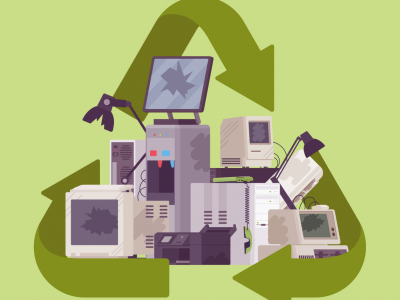
The Best Ways to Dispose of Old Electronics and Devices
With the holiday season approaching, you may be eagerly anticipating buying or gifting a shiny new cell phone, tablet, or other electronic device. But what about the outdated devices, batteries, and cords shoved into a drawer? Or the old monitor collecting dust in the back of your closet?
The number of “old” devices that are being discarded annually (called “e-scrap”) continues to grow as more people adopt more electronics into their lives—and ultimately update them to newer models with additional features.
Discarding outdated electronics with your household garbage causes a two-fold problem—it reduces electronics manufacturers’ access to necessary, expensive materials, and it releases dangerous toxins into the environment.
Why E-Scrap is Different
Unlike other household garbage, e-scrap includes the remnants of rare and precious metals used in its production—materials that qualified e-scrap companies can reclaim.
Some of those rare metals include indium, gallium, yttrium, and europium, found in fluorescent lamps, display panels, and solar panel cells.
Other precious metals in old electronics include gold, silver, platinum, and palladium, all found in circuit boards, CPU chips, memory chips, and other electronic scraps.
Discarded electronics can also contain environmental toxins, including:
- Lead, mercury, and cadmium in certain types of batteries and printed circuit boards.
- Mercury in flat screen devices.
- Polychlorinated biphenyls (PCBs) in older televisions, electrical appliances, and computers.
- Leaded glass in old CRT displays, monitors, and televisions.
When electronics are added to household trash and piled up in landfills, these and other toxins can leach into the ground, affecting underground aquifers and nearby waterways.
You may be able to upcycle old devices. But if your priority is reducing the clutter in your home, there are preferable options for disposing of old electronics:
1. Sell it.
If your device is relatively recent, you may be able to get a discount by “trading in” for an upgrade. Check with your current cell service provider.
Apple will provide a credit toward purchasing any new Apple product if you trade in an eligible Apple device—or an Android.
If you want to sell your device outright, consider using a local or national online marketplace. For example, Swappa specializes in buying and selling used phones, laptops, tablets, and other technology.
2. Donate to great causes.
Perhaps your old phone can be refurbished and used by others in need? There are numerous ways to help people and communities:
- Donate your phone to Cell Phones for Soldiers.
- Help victims of domestic violence via the NCADV.
- The 911 Cell Phone Bank and Secure the Call help vulnerable residents nationwide.
- Medic Mobile provides refurbished mobile devices to health workers across the globe.
- SecondWave Recycling supports numerous charities through cell phone recycling.
- Cellular Recycler helps companies and non-profits host collection drives and accepts individual donations.
3. Recycle responsibly.
Electronics recycling is about much more than cell phones. Printers, monitors, televisions, cameras, modems, and more should all be disposed of safely.
Contact your area’s solid waste coordinator for guidance and a list of certified electronics recyclers operating in your state or region for local options.
The EPA encourages electronics recyclers to have Responsible Recycling (R2) and e-Stewards certifications to make sure they are safely handling recycled materials.
Another option is to return your devices to one of the major retailers. For example, Best Buy has a comprehensive program. Other alternatives include Staples and Amazon.
For battery recycling laws in each state and local drop-off locations, visit Call2Recyle.
Protect Yourself While Doing Good
Be sure any recycling option or electronics donation drive is a valid one. Do your due diligence and permanently remove all your personal and sensitive data before donating or recycling any device.
